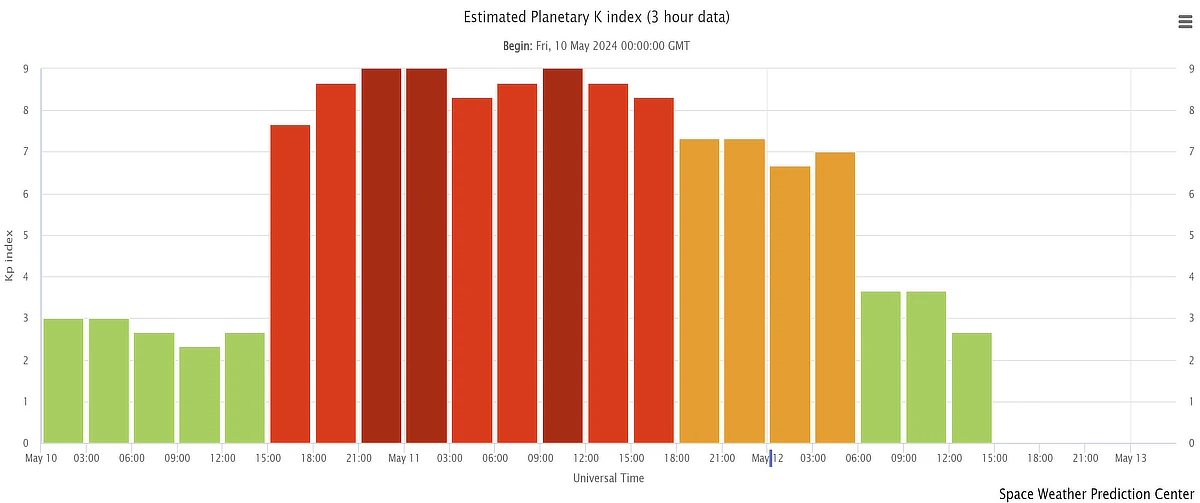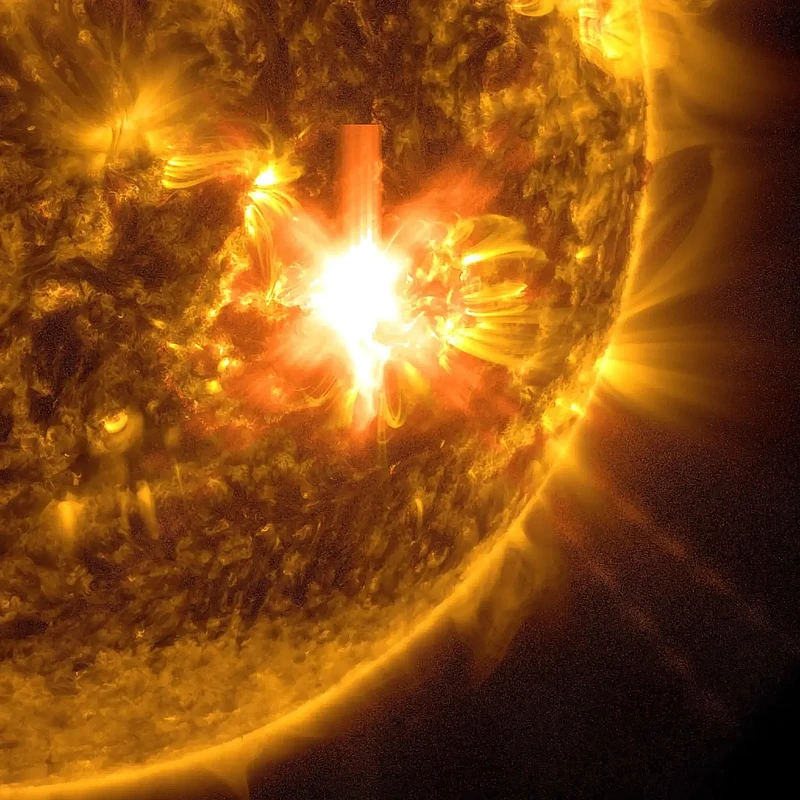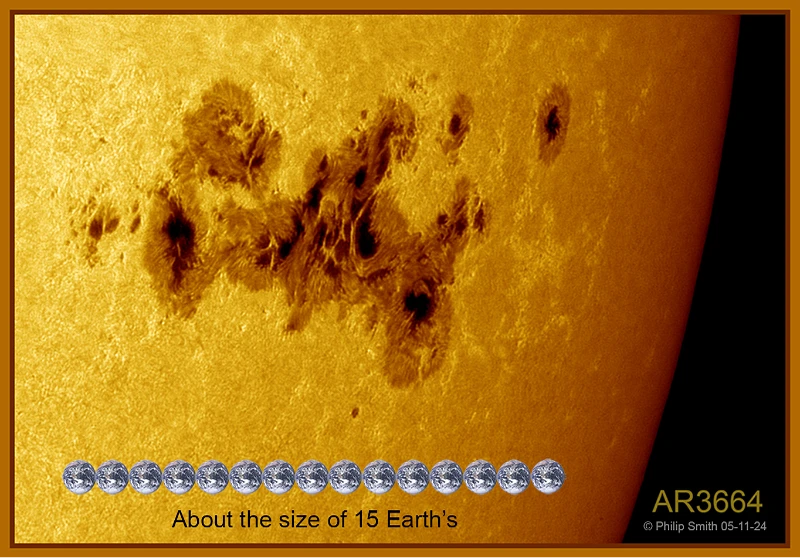Solar Storm 2024

The Solar Storm of May 2024. A very significant geomagnetic storm event. A storm like this has not been seen since the Halloween solar storms of 2003 (I remember that!) when stunning ‘Northern Lights’ were seen all around the world. Similar to that event, the recent Aurora Borealis has been spectacular.
Although the sky was partly to mostly cloudy in my region of New Hampshire the other night, the Northern Lights were incredible. The sky was brightly lit, green. At times, shimmering ‘sheets’ dangled in the sky when clouds gave way to reveal the spectacle. Ongoing the second night, the sky was lit a bluish-green hue. Again, incredible. Tonight, the third and final night of this event is forecast to again set the night sky ablaze with Northern Lights as yet another CME may strike the earth.
Update, May 13, 2024:
NOAA forecasters say that the storm is over now.The historic geomagnetic storm of May 10-11, 2024, produced auroras across Europe, Asia, Mexico, and all 50 US states–even Hawaii. Hundreds of millions of people saw the colored lights for the first time in their lives.
SpaceWeather.com
Solar Flare versus Coronal Mass Ejection (CME)
Here’s a great analogy from Dr. Peter Becker, a professor of George Mason University, Physics and Astronomy Department. I will summarize it…
Solar flares are when the sun brightens and we see the radiation bursting from the sun. That’s kind of the ‘muzzle flash’. The ‘cannon shot’ is the coronal mass ejection (CME).
We can tell (via scientific instruments onboard satellites) whether the CME is headed our way toward Earth. This gives us about 18-24 hours’ warning before the particles actually make it to Earth and start interacting with the Earth’s magnetic field.
I heard this during an interview on FoxWeather while discussing the possibility of a Solar superstorm that could ‘wipe out the internet’ for weeks or months (or longer). I recommend listening to what Peter had to say – quite interesting… (here’s the link).
What happens when a CME gets to Earth?
You get magnetic distortions of Earth’s magnetic field. We can sometimes see the visible effects by a phenomenon known as the Northern Lights, when charged particles from the sun interact with the Earth’s magnetic field and atmosphere.
More importantly, the magnetic distortions from a CME drive inductive currents into power lines, potentially affecting the power grid, tripping circuit breakers or even burning up transformers and other equipment. These magnetic distortions can also drive inductive currents into the surface of the earth and through the ground, which is yet another ‘back door’ way to wreak havoc on today’s electrical systems.
In essence, a sufficiently powerful CME poses a risk to the power grid, satellites, GPS systems, and communication equipment.
G5 Extreme Solar Storm 2024

Image Credit: NASA/Solar Dynamics Observatory. A NASA satellite recorded the sun releasing a powerful solar flare on May 10, 2024.
On May 8, 2024, sunspot region AR 3664 unleashed its first X-class flare. This was followed by seven more X flares (updated), the most powerful being an X5.89 on May 11.
These solar flares were accompanied by solar Coronal Mass Ejections (CME) that began to arrive at Earth about 34 hours later. This is what caused the onset of Solar Storm 2024. We’ll see how the rest of the year goes, as we are at the peak of the current Solar Cycle 25, but so far this was the big one.
This solar storm occurred over several days as round after round of CMEs impacted Earth’s magnetic field. The end result was a solar storm that reached the highest end of the NOAA geomagnetic storm scale, G5 Extreme.
G5 (Extreme): Kp value of 9. Extreme power grid fluctuations can occur, and widespread damage to power systems and satellite operations is possible.
As of this posting, I am aware of several resulting issues from this solar storm in 2024.
- SpaceX’s Starlink satellite internet service (I experienced some glitches with it myself),
- The SWPC reported that there were reports of power grid irregularities and degradations to high-frequency communications and GPS.

Image Credit: Taken by Philip Smith on May 11, 2024 @ Manorville, NY USA. It shows sunspot region AR3664 approaching the sun’s western limb, about the size of 15 Earth’s, comparable to Carrington’s sunspot (worst in history). We dodged a bullet.
Source: SpaceWeather.com Image Gallery
Preparing For An Extreme Solar Storm
Spoiler Alert: Prepare for grid down. How long? Plan for the worst. Hope for the best.
A solar storm will not physically affect you. However, the effects could impact electrical systems (including the power grid), and affect you in that way. I chuckled upon hearing preparedness recommendations from many mainstream outlets regarding this solar storm. In essence, they said to have a flashlight (in case the power goes out), and there’s nothing else you can do except enjoy the Northern Lights. In other words, just keep your head in the sand, so to speak.
While I do enjoy the science of this astronomical event, and observing the resultant light show, this type of extreme solar storm is one of several major types of events that I have prepared for to an extent. Why? Because I’m a sensible preparedness-minded person with some instincts of self-preservation.
As of this post, Solar Storm 2024 has not taken down the electrical grid or sections thereof. However, a very powerful CME event could absolutely take down the grid. Thankfully this one did not.
You might wonder, If a geomagnetic solar storm did take down the power grid, how long would it be out? No one knows for sure. But it could be a medium-while, or it could be a long-while. Weeks. Months. Maybe longer or much longer depending on the damage.
The best way to prepare is the same way for a grid-down situation.
Preparations are no different from that of preparing for cyberattack/grid-down, EMP/grid-down, or any other way that the power grid may go down. Be it short-term, medium-length, or long-term.
In the particular case of a geomagnetic solar storm being in the extreme category, the odds of the power grid going down may be significant, if and when this type of event does occur. How often does this happen? Well, there was an extraordinary near-miss during 2012 that likely would have been disastrous. But the last somewhat equivalent event that hit us was about 20 years ago. A solar storm did take parts of the grid down in 1989 (Quebec), and I’m sure that many of you have heard of the Carrington Event of 1859 (really bad!)?
But today, being right in the middle of the current peak of Solar Cycle 25, one would expect the odds to be greater than otherwise (though experts say that it could happen during off-peak too).
The thing is, you’re going to need more than a flashlight to be even somewhat prepared for an extreme solar storm that could bring down the grid for a time.
Imagine the many effects of life without electricity for weeks, months, or longer. Then begin your preparations if so inclined. Don’t do it out of fear. I do this sort of thing because I find it enjoyable, satisfying, and rewarding. I’m sure that many of you would too. Living a self-reliant lifestyle builds a better you, in my opinion…
My first big implement for grid down interruptions? A solar power system with a battery bank for 24/7 off-grid electricity for the homestead. It’s installed side by side with the existing utility power grid, and I can switch individual electric circuits to source from one or the other. Costly and time consuming (did it myself), but awesome peace-of-mind.
When this G5 solar storm began, I switched off my mains circuit breaker in the electrical panel, isolating myself from the potential risk of inductive DC currents and fluctuating power induced into the power lines (if it were to get bad enough). I went completely off-grid for several days. It was a fun ‘test’. Try it sometime :=)
You can take this type of preparedness as far as you want to. It’s all up to you.
Solar Storm 2024 was a reminder. The grid is vulnerable, and we rely on it for modern survival.
